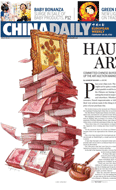Art
The Dai paper cut-out
Updated: 2011-02-14 14:04
(Chinaculture.org)
The paper cut-out, a very distinctive visual Chinese handicraft, is practiced by farming women all over China. However, one may be surprised to see that most of skilled hands at creating paper cut-outs are men in Dehong Autonomous Prefecture, Yunnan province, where the Dai ethnic group resides.
 |
Present throughout China and in various ethnic groups, the paper cut-out is a popular art integral to everyday lives. Though the paper cut-out requires very simple skills, its content is rich and reveals many local Chinese customs.
 |
The Dai paper cut-out is the traditional folk art of the Dai ethnic group. It grew out of the paper streamers used in sacrificial ceremonies of the Dai, which then gradually evolved into a systematic technique under the influence of Buddhist culture and the culture of Central China, and were extensively applied in sacrifices, contributions to the Buddha, funerals, festivals and home decoration. Almost every Dai villager in Dehong can fashion paper cut-outs, the contents of which are full of life and local flavor. The paper cut-out is largely influenced by Buddhism, the religion of the ethnic group, especially in its use of stories from the sutra, folklore and local specialties.
 |
Through the paper cut-out, the Dai follow a proud Chinese tradition, albeit adapted to meet the specific cultural and artistic aspirations of the Dai ethnic group. Unlike paper cut-outs of the Han people, the Dai paper cut-outs not only cut paper, but also use cloth and metal foil as raw materials for their artistic creation. The main cutting tools are simple: scissors, an engraving knife, a carving chisel and a hammer.
 |
There are two methods of creating paper cut-outs: cutting and chiseling. When using scissors, skillful Dai people need no design sample; the design flows with their thoughts. The Dai people can chisel more than 8 layers of paper or metal foil at a time. They first copy a complex motif and patterns on one piece of paper, fix the design together with a stack of carving materials, then grasp the carving chisel in an upright position and press evenly on the paper with some strength along the lines. Flexibility is required, but any hesitation or wiggling will lead to imprecision or damage the whole image.
 |
Clever and deft craftspeople are remarkably good at cutting out scenes of daily life. When you look at items made carefully with this method, you will be amazed by the lifelike expressions of the figure’s sentiment and appearance, or portrayal of natural plants and animals’ diverse gestures.
In the world of paper cut-out art, the skillful folk craftsmen make full use of their imaginations to create various works of beauty and originality. Most of the patterns of paper cut-out are from the paper cut-out drawing, which is used as well to design patterns on household articles such as bed linen, bags and hats. The Dai paper cut-out motifs are beautiful and intricate, composed of images of grass, trees, insects, animals and humans, all interacting in a harmonious way. Others contain a more specific set of story-telling images relevant to Dai culture, as well as to more local traditions.
 |
As one of the branches of paper cut-out in China, the Dai paper cut-out was successfully inscribed in 2009 on UNESCO’s List of Intangible Human Cultural Heritage, together with paper cut-outs of 14 other provinces.
As a key part of Chinese social life in all ethnic groups, paper cut-outs express the moral principles, philosophies and aesthetic ideals of its exponents. It continues to provide an outlet for emotion and is experiencing an unprecedented revival.
E-paper

Ear We Go
China and the world set to embrace the merciful, peaceful year of rabbit
Preview of the coming issue
Carrefour finds the going tough in China
Maid to Order
Specials

Mysteries written in blood
Historical records and Caucasian features of locals suggest link with Roman Empire.

Winning Charm
Coastal Yantai banks on little things that matter to grow

New rules to hit property market
The State Council launched a new round of measures to rein in property prices.
